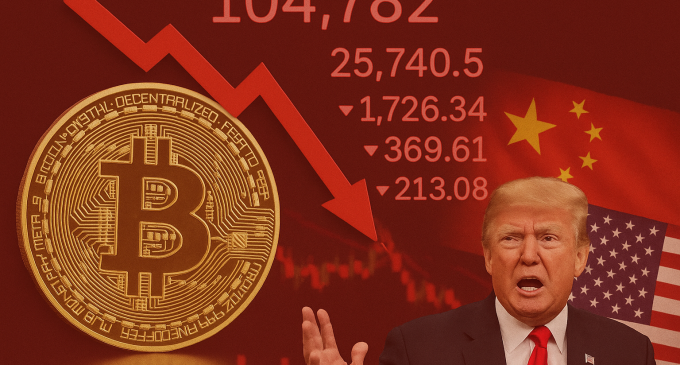
Introduction
The global financial landscape witnessed a dramatic shift as Bitcoin, the world’s leading cryptocurrency, tumbled to 104,782 dollars on October 10, 2025, marking one of its steepest intraday declines in months. The sudden drop came amid growing geopolitical tensions between the United States and China after U.S. President Donald Trump announced an aggressive new round of tariffs on Chinese exports. The move sent shockwaves through traditional markets and digital assets alike, triggering widespread panic and liquidations across major exchanges.
For several weeks, Bitcoin had been trading near record highs above 120,000 dollars, supported by robust inflows into newly launched exchange-traded funds and rising institutional participation. However, the announcement of additional tariffs reignited fears of a global economic slowdown, driving investors away from risk assets. Bitcoin, often viewed as both a hedge and a speculative asset, bore the brunt of the sell-off as traders rushed to unwind leveraged positions.
The Trigger: Trump’s Tariff Escalation Sparks Market Panic
The sharp decline in Bitcoin’s price was directly linked to President Trump’s declaration of a one hundred percent tariff increase on selected Chinese goods. This unexpected escalation of the U.S.-China trade conflict reignited concerns about the stability of international trade and the potential for retaliatory measures from Beijing. The resulting uncertainty cascaded across financial markets, with equities, commodities, and cryptocurrencies all experiencing steep declines.
In previous trade disputes, investors often treated Bitcoin as a potential safe-haven asset, similar to gold. However, this time the reaction was markedly different. Rather than rising on geopolitical fear, Bitcoin mirrored the sell-off seen in equities, suggesting that investors were treating digital assets more as risk-on instruments rather than defensive hedges. Analysts pointed out that the sheer volume of leveraged positions in the crypto market magnified the downward move, turning what began as a macroeconomic reaction into a full-scale liquidation event.
Massive Liquidations And Exchange Turmoil
The crypto derivatives market faced intense pressure as over sixteen billion dollars worth of leveraged long positions were liquidated within hours. On major exchanges such as Binance, OKX, and Bybit, cascading margin calls led to forced selling, amplifying the decline in spot prices. Data from Coinglass indicated that more than three billion dollars of liquidations occurred in a single hour, making it one of the most volatile trading sessions of 2025.
Market participants described the event as a flash crash fueled by excessive leverage and thin liquidity. The rapid drop to 104,782 dollars was followed by a swift recovery toward 110,000 dollars as opportunistic buyers stepped in, but the damage to investor sentiment had already been done. Many traders who had entered the market expecting Bitcoin to break new all-time highs found themselves caught in a wave of liquidations.
Exchanges responded by temporarily increasing margin requirements and slowing withdrawals to stabilize order books. Despite these measures, volatility remained elevated, and analysts warned that Bitcoin could face additional pressure if global markets continued to slide.
Global Market Reaction And Risk-Off Sentiment
The broader financial markets echoed the turbulence seen in crypto. Wall Street opened sharply lower following Trump’s announcement, with the Dow Jones Industrial Average falling by more than three percent. Asian markets also declined as Chinese officials hinted at possible retaliatory tariffs. In this environment, investors sought safety in traditional hedges such as the U.S. dollar and Treasury bonds, both of which strengthened significantly.
This shift toward a risk-off stance proved detrimental for Bitcoin and other digital assets. Ethereum, Solana, and other major cryptocurrencies registered double-digit percentage losses, erasing billions of dollars in market capitalization within hours. The combined crypto market value fell below two trillion dollars for the first time in six weeks, underscoring the fragility of investor confidence.
Financial analysts noted that the recent strength in Bitcoin had been built on optimism surrounding institutional adoption and favorable regulatory developments. However, the tariff announcement exposed how quickly that sentiment could reverse when macroeconomic shocks hit.
ETF Inflows And The Fragile Rally Before The Fall
Just days before the market meltdown, Bitcoin had been enjoying a strong rally fueled by record inflows into cryptocurrency exchange-traded funds. Data from Bloomberg and CoinShares indicated that global crypto ETFs attracted nearly six billion dollars in net inflows during the first week of October. This surge in institutional interest had pushed Bitcoin to a high above 125,000 dollars, sparking speculation that a new bull cycle was underway.
Investors viewed the ETF growth as a sign of mainstream acceptance, and major financial firms had begun increasing exposure to digital assets. The optimism, however, masked underlying vulnerabilities in the market’s structure. Leverage levels across both retail and institutional accounts had reached historic highs, leaving the market susceptible to rapid corrections. When the trade-war escalation hit, those vulnerabilities were exposed in full force.
Several analysts compared the situation to earlier flash crashes in 2021 and 2022, when over-leveraged traders were wiped out in a matter of hours. The combination of record leverage, high valuations, and macroeconomic uncertainty created the perfect storm that brought Bitcoin’s rally to a sudden halt.
Technical Breakdown And Key Support Levels
From a technical standpoint, Bitcoin’s decline below 110,000 dollars represented a major breakdown in its short-term bullish structure. The 110,000 level had served as strong support throughout September and early October. Once that threshold was breached, automated trading algorithms accelerated selling momentum.
Analysts pointed to the 100,000 dollar level as the next critical zone of support. A sustained break below that price, they warned, could open the door to a deeper correction toward 90,000 dollars. Conversely, a rebound and close above 115,000 dollars would indicate that buyers were regaining control and could potentially restore the uptrend.
Despite the severity of the decline, some technical indicators such as the Relative Strength Index suggested that Bitcoin had entered oversold territory, hinting at a possible short-term recovery. Traders were advised to exercise caution, as the broader macroeconomic environment remained highly uncertain.
Institutional Investors React To Market Shock
Institutional reaction to the sell-off was mixed. Some hedge funds viewed the decline as a buying opportunity, citing Bitcoin’s long-term potential as a store of value in an era of monetary instability. Others took a more defensive stance, trimming positions and reallocating capital toward less volatile assets.
Several large investment firms issued notes to clients emphasizing the need for disciplined risk management. Goldman Sachs analysts remarked that the recent correction underscored Bitcoin’s sensitivity to macroeconomic events, despite its decentralized nature. They argued that while the asset class had matured considerably since its early days, it still behaved more like a high-beta risk asset than a safe haven.
Family offices and institutional portfolios that had diversified into crypto ETFs also experienced notable drawdowns. However, fund managers maintained that their long-term outlook remained positive, citing increasing regulatory clarity and continued innovation in blockchain technology as reasons for optimism beyond the short-term turmoil.
Global Economic Implications Of The Trade War
The renewed U.S.-China trade conflict has far-reaching implications for the global economy. The new tariffs are expected to disrupt supply chains, increase production costs, and potentially raise consumer prices. Economists warn that if the dispute escalates further, it could slow global GDP growth and strain international trade relations.
For the crypto market, the situation presents a paradox. On one hand, economic instability and currency devaluation could boost demand for decentralized assets like Bitcoin. On the other hand, reduced liquidity and risk aversion could limit speculative activity, leading to lower prices in the short term.
Market strategists believe that much depends on how China responds. If Beijing retaliates with its own measures, investors may brace for an extended period of volatility. Conversely, if diplomatic negotiations resume, the pressure on risk assets might ease, allowing Bitcoin and equities to stabilize.
The Psychology Of Fear And Market Behavior
Beyond technical and macroeconomic factors, the psychological dimension of market behavior played a key role in the recent crash. The speed and scale of the sell-off triggered fear among both retail and institutional investors. Social media platforms were flooded with panic-driven commentary, contributing to a feedback loop of negative sentiment.
Crypto markets, which operate twenty-four hours a day, are particularly vulnerable to emotional trading. Without traditional circuit breakers, price swings can accelerate rapidly as traders react to each other’s moves. Analysts observed that many participants who entered the market during the bullish ETF wave were unprepared for such volatility, leading to forced liquidations and emotional decision-making.
Behavioral economists argue that these episodes highlight the importance of investor education and risk management. They emphasize that despite its growing legitimacy, Bitcoin remains a highly speculative asset subject to extreme fluctuations driven by global events and trader psychology.
Outlook For The Weeks Ahead
Looking ahead, the outlook for Bitcoin remains uncertain. Market watchers are closely monitoring developments in the trade negotiations between the United States and China, as well as the broader trajectory of global economic indicators. A de-escalation of trade tensions could restore confidence and support a rebound in risk assets. However, if the conflict intensifies, Bitcoin could face prolonged pressure alongside equities and commodities.
Some analysts remain cautiously optimistic. They point to Bitcoin’s historical resilience, noting that every major correction has eventually been followed by a recovery to new highs. The asset’s scarcity, decentralized nature, and growing institutional adoption continue to underpin its long-term investment thesis.
Others warn that the market may enter a consolidation phase as traders reassess risk. In this scenario, Bitcoin could trade in a wide range between 100,000 and 120,000 dollars for several weeks before a clear direction emerges.
The Broader Significance Of The Sell-Off
The October 2025 sell-off carries broader significance for both the cryptocurrency ecosystem and global financial markets. It underscores how deeply interconnected the digital asset space has become with traditional economic forces. The idea of Bitcoin as a completely independent asset class is being redefined as macroeconomic events increasingly influence its price movements.
Furthermore, the episode highlights the maturity of the crypto infrastructure. While the market experienced severe turbulence, major exchanges and custodians remained operational, and no systemic failures were reported. This resilience, despite extreme volatility, demonstrates how the industry has evolved since earlier crises.
At the same time, the event serves as a reminder that regulation, leverage management, and investor education are critical for sustainable growth. Policymakers and financial institutions are likely to analyze the lessons from this episode to better understand how to integrate digital assets into the global financial framework without amplifying systemic risk.
Conclusion
Bitcoin’s decline to 104,782 dollars on October 10, 2025, will be remembered as a defining moment in the ongoing evolution of the cryptocurrency market. Triggered by a sudden escalation in the U.S.-China trade war, the sell-off exposed both the strengths and vulnerabilities of digital assets. It demonstrated that while Bitcoin has achieved unprecedented mainstream acceptance, it remains deeply intertwined with global economic dynamics.
As markets continue to navigate an era of geopolitical uncertainty and monetary shifts, Bitcoin’s role will likely keep evolving. For some, the correction represents a temporary setback in a long-term growth story. For others, it is a cautionary tale about the volatility inherent in an asset class still finding its place in the global economy.







There are no comments at the moment, do you want to add one?
Write a comment